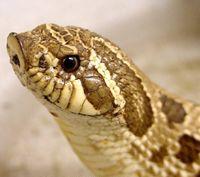Hognose - Western
Scientific Name: Heterodon nasicus
Thu, 17th April, 2025 - 8:50 am GMT
Sponsor Ads:

Alternative Name
Scientific Name: Heterodon nasicusBasic Info
The Western Hognose Snake is a rear fanged, mildly venomous, snake. These snakes rarely ever bite in defense, however. Western Hognose Snakes have cute, upturned noses that are used for burrowing, and are thick bodied with keeled scales. Males have significantly longer tails than females. The average Western Hognose Snake can reach up to 3 feet in length and are seen in colors that range from cream to brown, with heavy light brown to dark brown blotching along the body and black markings on the under side of the tail
Health
Breeding After hibernation, the female should have eaten at least four meals before you introduce the male Western Hognose Snake. In the wild, these snakes generally breed from March to April. Watch the snakes carefully upon introduction to make sure the female does not eat the male; should the Western Hognose female thrash her tail back and forth, this is a good sign. It means she is interested in the male you have brought her! After mating, remove the male. The gravid Western Hognose female will show an abdominal swelling if she is not particularly fat. Place a three to four inch deep nesting box filled three-quarters full with sphagnum moss in the cage. Leave a one and a half inch diameter hole in the top of the nesting box. The Western Hognose Snake will be restless and burrow a lot for a few days before laying. Five to 25 eggs are usually laid. Western Hognose Snakes may store sperm and lay more eggs up to six months after the first clutch. After a six-week incubation at about 80 degrees Fahrenheit, the eggs hatch. Neonates should be fed on pinkie mice and will shed immediately. Pinkies may need to be scented with frogs or lizards before they will be accepted by the Western Hognose Snakes.Habitat
N/ABehavior
The Western Hognose snake can be described as 'the drama-queen of the reptile world'! Its best defense is its mimic act. A great entertainer when frightened, the Western Hognose Snake is generally docile. Its favorite imitations are those of the rattlesnake and the cobra! Though generally peaceable and shy, when faced with a predator the Western Hognose is left with no choice but to take action. It coils itself up, and like a Cobra fans out its head and neck. Like a Rattlesnake, the Western Hognose Snake will begin to strike repeatedly- though not necessarily in the direction of the danger. Should this convincing display fail to scare away the danger, the Western Hognose will dramatically drop to the ground, stick its tongue out, writhe with mouth open, roll over, and freeze into a role-play of death. Should you think you are clever and roll it over again, it will immediately flop onto its back and play dead until it feels danger is past. In captivity, this performer will cease to act once it is used to your presence, but the behavior is instinctual - even captive born babies will indulge in acting occasionally. In the wild, however, the Western Hognose would be better off slithering quickly away - most mammals and birds of prey have no qualms about eating a "dead" snake. These snakes can be stubborn eaters, and some become impossible to feed, so it is best to buy captive bred snakes, which have already eaten several meals. In the winter, Western Hognose snakes hibernate, and in captivity will not eat from October to December. A fresh bowl of water is also important at all times. Hibernation should be simulated in captivity by slowing lowering the temperature in your Western Hognose snake's enclosure. When the snake has not eaten for two weeks, move it onto some aspen bedding in a sweater box and keep it in a dark place at about 57 degrees Fahrenheit, simulating the always-dark rodent hole he would use in the wild. Provide fresh water and check the Western Hognose Snake each week; should he seem sick or thin, gradually "thaw" the snake by raising the temperature over a period of days and then treat him.Origin
North AmericaHistory
The Western Hognose is native to the sandy savannahs and prairies of much of the south and Midwestern United States in addition to northwest Manitoba and southern Alberta. Occasionally found also in Northern Mexico, the Western Hognose Snake is preyed upon by medium sized mammals and raptors. They are threatened by loss of habitat.Common Foods
Western Hognose snakes eat toads, eggs, birds, small amphibians, and small mammals in the wild. They will even dig for prey in the sand with their flat noses. In captivity, Western Hognose snakes do nicely on mice once a week.Sponsor Ads:
Design a system an idiot can use and only an idiot will want to use it.
Hognose - Western
Coded by: BGID® | ALL RIGHTS RESERVED Copyright © 2000-2025
Disclaimer | Privacy | Report Errors / Contact | Credits


 Preparing For China. China is growing their military. China Military Technology - can it keep up with the US?
Preparing For China. China is growing their military. China Military Technology - can it keep up with the US?  versus
versus 

 versus
versus 
 This Thread is about the North Korean Military itself - the kind of army, navy, and air force they have.
This Thread is about the North Korean Military itself - the kind of army, navy, and air force they have. 
 versus
versus 
 versus
versus  versus
versus